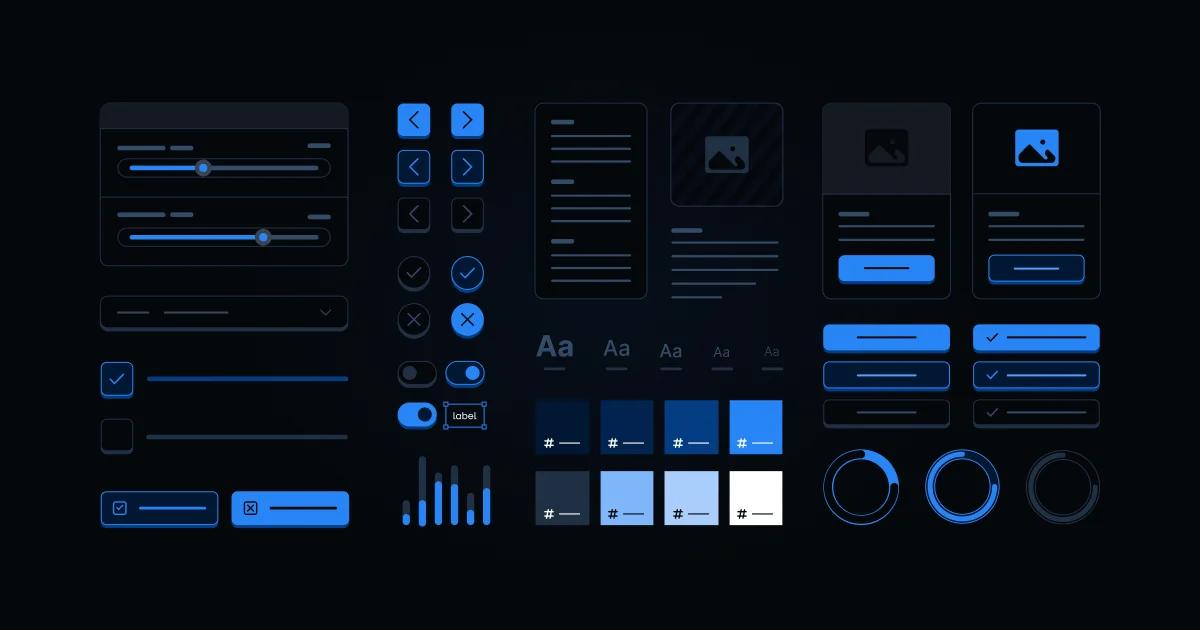Good UI directly impacts your bottom line through improved user engagement, higher conversion rates, and increased customer satisfaction. This guide will show you how to create interfaces that not only look great but also drive meaningful business results.
In brief:
- Good UI design directly influences user engagement, conversions, and customer satisfaction.
- Key principles include clarity, simplicity, visual hierarchy, consistency, feedback, and accessibility.
- Implementing best practices like simplifying interfaces, optimizing forms, and designing for mobile can enhance user experience.
- Building a UI design system and using testing and iteration are essential for creating effective interfaces.
Core Principles of Effective UI Design
Effective UI design is the foundation of a successful digital product, directly impacting user engagement, conversion rates, and business success. By adhering to core principles and staying aware of upcoming UX design trends for 2025, you can make sure your UI remains effective and ahead of the curve.
Prioritize Clarity and Simplicity
Your interface should communicate its purpose without confusion. Remove unnecessary elements and maintain clean layouts that guide users to their goals. For example, when designing a signup form, only request necessary information—research shows that many e-commerce sites can reduce their checkout fields by 20–60% without losing necessary data.
Establish Visual Hierarchy
Guide users' attention through intentional design choices. Use size, color, and contrast to emphasize key elements, and employ whitespace to create logical groupings. Primary actions should stand out—make your main call-to-action button more prominent than secondary options.
Maintain Consistency
Maintain uniform design patterns throughout your interface. Use consistent colors, typography, button styles, and spacing. Consistency reduces cognitive load and builds user confidence. For instance, if you use a gear icon for settings in one section, maintain this convention throughout the interface.
Provide Clear Feedback
Users need to know their actions have been registered. Provide immediate visual feedback for interactions, show loading states for processes, and display clear error messages when something goes wrong. Studies indicate that poor feedback mechanisms are a common reason for users abandoning websites.
Implement Accessibility Standards
Design for all users, including those with disabilities. Embracing accessible web design involves using sufficient color contrast, providing text alternatives for images, and verifying that keyboard navigation works properly. Accessibility isn't just good practice—it has significant business implications, as 94% of top-grossing sites have basic accessibility compliance issues, potentially excluding valuable customers and risking legal issues.
Implementing these principles directly affects your bottom line—they aren't just theoretical. For instance, 63% of mobile users have abandoned a site at least once due to preventable usability issues. Applying these core principles effectively creates interfaces that look professional and drive business results through improved user engagement and conversion rates.
5 Essential UI Design Best Practices
1. Simplify and Clarify
Start by eliminating unnecessary elements from your interface. Every button, image, or text block should serve a clear purpose. For example, instead of cramming multiple calls-to-action above the fold, focus on one primary action that aligns with your main conversion goal. Utilizing interactive landing page features can enhance user engagement while keeping the interface clean and focused. This approach reduces cognitive load and guides users more effectively toward desired actions.
Companies that have simplified their homepages to focus on a single CTA have seen significant increases in qualified lead generation. Key implementation points:
- Remove redundant navigation options
- Use clear, action-oriented button labels instead of generic text
- Maintain adequate white space to help key elements stand out
- Group related information into logical sections
2. Maintain Consistent Patterns
Consistency in your UI creates predictability, which builds user confidence and reduces learning curves. According to Baymard Institute's research, inconsistent interfaces are a major source of user frustration and abandonment. Implement these practices:
- Use the same button styles for similar actions throughout your site
- Maintain consistent spacing between elements
- Keep navigation patterns uniform across all pages by implementing effective navigation strategies
- Apply the same interaction patterns (hover states, click behaviors) site-wide
3. Optimize Forms for Conversion
Forms are often the final hurdle between users and conversion. Optimizing forms is an essential step in improving CRO with UX. Research shows that many websites can reduce their form fields by 20–60% without losing necessary information. To optimize your forms:
- Only ask for information that's absolutely necessary
- Use inline validation to provide immediate feedback
- Break long forms into logical steps
- Auto-fill fields when possible using browser capabilities
4. Design for Mobile Users
With 63% of users abandoning sites due to mobile usability issues, mobile optimization isn't optional. Using a comprehensive responsive design checklist can help ensure your site performs well on all devices. Focus on these aspects:
- Make touch targets at least 44x44 pixels
- Optimize page load times for mobile networks
- Adapt navigation patterns for thumb-friendly interaction
- Prioritize content display for smaller screens
5. Provide Clear Feedback
Users need to know their actions have been registered and understood. Implement clear feedback mechanisms:
- Show loading states for all actions that take more than 500ms
- Provide success confirmations for significant actions
- Display clear error messages with actionable solutions
- Use micro-animations to acknowledge user interactions
Remember, these practices aren't just about aesthetics—they directly impact your bottom line. Implementing them systematically can create interfaces that look professional and drive measurable improvements in user engagement and conversion rates.

How to Create a UI Design System
A UI design system serves as the single source of truth for your product's interface elements, providing consistency and scalability across your digital products. By understanding design systems and establishing a comprehensive system of reusable components, documentation, and guidelines, you can streamline your design and development process while maintaining a cohesive user experience.
Start by defining your core components library. This should include standardized versions of common UI elements:
- Typography schemes with specific font families, sizes, and weights
- A consistent color palette with defined use cases
- Button styles and states
- Form elements and input fields
- Icons and imagery guidelines
- Spacing and layout grids
- Component variants for different responsive breakpoints
Documentation is key for the success of your design system. Create detailed guidelines for each component, explaining their purpose, usage rules, and implementation details. Include code snippets, visual examples, and accessibility requirements. According to research by Nielsen Norman Group, organizations typically allocate 10–11% of their project resources to UX efforts, including design system maintenance.
To promote effective team collaboration, implement a centralized platform where designers and developers can access and contribute to the design system. Use specialized tools such as design system management platforms to manage your component library and maintain version control. Regular review sessions with your team help keep the system up-to-date and aligned with evolving product needs. Consider the typical ratio of 1 researcher to 5 designers to 50 developers when planning your design system governance structure to support proper maintenance and evolution of the system.
Remember that a design system is a living document that should grow and adapt with your product. Regular updates, clear contribution guidelines, and consistent governance maintain its long-term value as a foundational tool for your product development process.
Testing and Iteration
Testing and iteration form the backbone of effective UI design, transforming assumptions into data-driven decisions. When it comes to enhancing UX design, implementing multiple testing methodologies allows you to gather comprehensive insights about your interface's performance.
Start with qualitative usability testing to understand how users interact with your interface. Conduct moderated sessions where users complete specific tasks while verbalizing their thoughts. This approach provides deep insights into user behavior and reveals pain points that analytics alone might miss.
Complement qualitative data with quantitative research using tools like heat maps and session recordings. These tools reveal patterns in user behavior across your entire user base. Heat maps show where users click, move, and scroll, while session recordings help identify where users struggle or abandon their journey.
For specific design decisions, use A/B testing to compare different variations. This method is particularly effective for testing button placements, color schemes, navigation patterns, and content layouts.
Track key metrics through analytics to measure the impact of your design changes, such as task completion rates, time on task, error rates, and user flow completion.
Remember to iterate based on the combined insights from all testing methods. When implementing changes, roll them out incrementally to measure their impact accurately. This systematic approach guarantees that each design decision is backed by concrete data rather than assumptions.
Our Take on Good UI Design
At Webstacks, we've witnessed firsthand how effective UI design can transform digital experiences. We believe that UI design is more than aesthetics; it's about crafting intuitive interactions that resonate with users. By focusing on clarity, consistency, and user-centric principles, businesses can create interfaces that engage and convert. We've helped clients reimagine their digital products through iterative testing and data-driven strategies, leading to measurable improvements in user satisfaction and business metrics. In our view, investing in UI design is investing in the overall success of your digital presence.
Conclusion and Next Steps
Creating an effective UI design requires balancing established principles with user-centric thinking. With users spending less than 15 seconds on a website, it's important to implement clear visual hierarchies, maintain consistency, and prioritize simplicity.
Start by conducting thorough user research, creating a comprehensive UI style guide, and testing your designs with real users. Focus on building a component library that maintains consistency across your digital product while adhering to accessibility standards.
Whether you tackle it internally or seek expert guidance, remember that good UI design is an ongoing process of refinement based on user needs.

Ready to optimize your SaaS website structure for growth? See the Webstacks difference: Schedule a brief discovery call today. Let us help you create a website that drives results.




